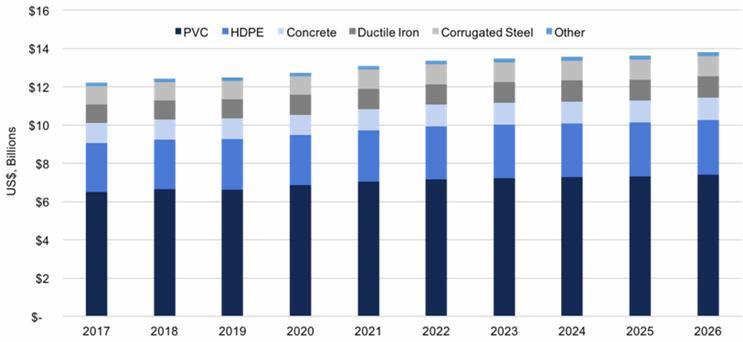Pipe Suppliers Aim To Capitalize On $300B Municipal Water Opportunity
Pipe and hardware companies are poised to benefit from heightening concerns about U.S. municipal water infrastructure and $300B of forecasted capital expenditures over the next decade, according to a new report from Bluefield Research, U.S. Municipal Pipe Markets: Trends, Opportunities and a Changing Competitive Landscape in Water.
Bluefield forecasts that new and replaced pipe and hardware infrastructure will make up more than 57% of municipal utilities' total capital spend through 2026.
"The public does not want to think, or even know, about the 1.6 million miles of pipes underground, but hundreds of thousands of water main breaks and lead-tainted water have begun to put a spotlight on this historically overlooked sector," says Reese Tisdale, President of Bluefield Research. "In fact, the average age of water pipes continues to climb — from 25 years in 1970 to 45 years in 2020 — largely because of underinvestment."
While municipal demand for pipe solutions, is expected to scale going forward, the pipe sector's material profile, for water and wastewater, is also being reshaped. New spending on pipes is showing the strong preference by utilities and engineering firms for plastic pipes — PVC and HDPE — which account for US$97B of the ten-year total. This trend highlights the continued growth of these materials, largely because of cost.
Total U.S. Municipal Water & Sewer Pipe Investments by Material Type, 2017-2026

Source: Bluefield Research
As pipe materials change, so does the highly fragmented supply chain. Companies are expanding their portfolios of pipe technologies and innovative solutions, and in some cases, entering new geographies to capitalize on growth. Leading players JM Eagle, Pipelife and North American Pipe, which are already ranked among the Top 10 suppliers by annual revenues, are positioned for growth.
At the same time, positive signals for increasing demand have sparked M&A activity. Bluefield has tracked 28 acquisitions of pipe companies, totaling US$6.3B, since the start of 2016. The most aggressive has been Forterra, a relative newcomer to the market, which has made nine deals over the last three years, placing it just on the outside of the top 10 leading players.
The scale of investment going into upgrading pipe networks is already driving more innovative, smarter solutions to stay ahead of rising costs. Over US$2.7B will be directed towards asset condition assessment and pipeline monitoring through 2026, while operating expenditures on leakage management, alone, will total $1B through the forecast period.
"Replacing water pipes is extremely labor intensive and costly, so utilities will increasingly be forced to look for ways to squeeze costs with more cost-effective materials, installation techniques, such as trenchless technologies, and network analysis." says Tisdale. "Certainly adoption will take time but innovative solutions are in front of them."
About Bluefield Research
Bluefield Research provides data, analysis and insights on global water markets. Executives rely on our water experts to validate their assumptions, address critical questions, and strengthen strategic planning processes. Bluefield helps key decision-makers at municipal utilities, engineering, procurement, & construction firms, technology and equipment suppliers, and investment firms advance their water strategies. For more information, visit www.bluefieldresearch.com.
Source: Bluefield Research
